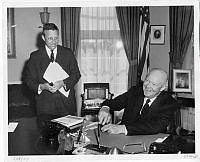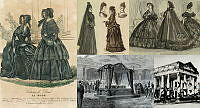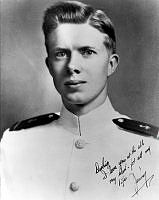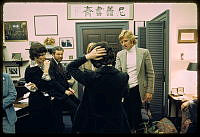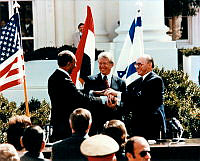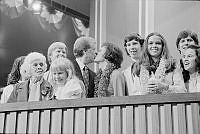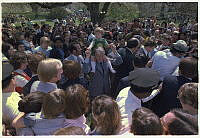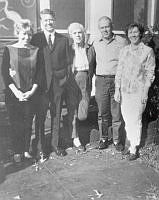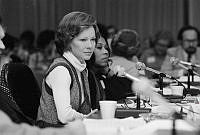Rubenstein Center Scholarship
Calvin Coolidge's Indelible Vacation to the Black Hills
The first vacations of President Calvin Coolidge were not very different from those of past presidents. Many commanders in chief returned home to briefly relax while fulfilling their presidential duties. President Coolidge often did the same in the early years of his administration. After two vacations along the east coast, however, the president decided to spend a summer in the Black Hills of South Dakota. His sabbatical was unique among presidential vacations.
Beside a faintly-lit oil lamp in August 1923, Vice President Coolidge was sworn in as the 30th President of the United States at his ancestral home in Plymouth Notch, Vermont.1 One year later, Coolidge and his family returned to Vermont for one of his initial retreats as president.2 An office for Coolidge was established on the second floor of the Plymouth Notch general store his family had once operated.3 Reporters who traveled with the president caught a glimpse into the childhood surroundings of “Silent Cal.”4 Perhaps the newspapermen better understood the president’s unique mannerisms by experiencing the humble quarters in which a young Calvin Coolidge grew up in.
President Coolidge’s Vermont vacation was followed by an excursion to the family’s White Court seaside mansion on the rocky shores of Swampscott, Massachusetts. Docked nearby was the presidential yacht Mayflower, which the president and his family used frequently for cruising. It was during Coolidge’s 1926 New York vacation to White Pine Camp in the Adirondacks5—under the guidance of his Head of Secret Service detail Edmund Starling—that the president became an avid fisherman.6 Henceforth, the hobby became a trademark pastime of Coolidge vacations.

An artist's rendering of Calvin Coolidge taking the presidential oath on August 3, 1923, at his family home in Plymouth Notch, Vermont.
Arthur J. Keller/Library of CongressNear the end of Coolidge’s third summer in office, he announced his desire to vacation out in the American West. Upon hearing this news, South Dakotans initiated a campaign to lure the president to the Black Hills. Stories of the beautiful landscape and plentiful spots for trout fishing were brazenly advertised. The campaign assured the president that he could “…fish all day…sleep well at night….ride into the Executive Offices at Rapid City three or four times a week….and come back to Washington a new man.”7 Coolidge agreed. By voyaging to the granite hills and fluting valleys of the Black Hills,8 Coolidge established a summer White House further west than any president before him.9
Large projects were immediately undertaken to ensure the summer White House would be ready for the president. Fresh gravel was spread along the 32-mile route between the summer lodge and Rapid City. Executive offices were established in a Rapid City high school, along with a telephone switchboard that connected the president directly to the Executive Mansion in Washington, D.C. Airplanes were set aside to deliver the president’s mail, and gasoline pumps were installed for the president’s caravan of automobiles. Great efforts were made to guarantee a satisfying and productive presidential sojourn in South Dakota.10
The vacation-bound president and his family departed Union Station in Washington with five canaries, two dogs, the first family’s pet raccoon Rebecca, and dozens of presidential aides.11 They broke up the cross-country train ride by frequently stopping to talk with everyday Americans along the way. Around five thousand supporters turned out to greet Coolidge as their train crossed the South Dakota state line.12,13

A photograph of the presidential yacht Mayflower in 1927 during the Calvin Coolidge administration.
Library of CongressPart of President Coolidge’s work during his vacation centered around helping the South Dakota economy. The president experienced the state’s need for infrastructure improvement by bouncing over the ungraded roads that weaved throughout the land. With the onset of automobile tourism, the ability to claim the Black Hills as a site of a presidential visit was crucial. South Dakota Senator Peter Norbeck wished to embrace the new mode of tourism to offset the farming troubles which plagued his state. In an effort to stimulate the state’s economy, President and Mrs. Coolidge helped publicize South Dakota’s tourist attractions by engaging in commerce with local businesses during their vacation. The Coolidge’s collaborations quickly proved beneficial. A multitude of Americans motored to the Black Hills for a glimpse of Coolidge within weeks after the president’s South Dakota debut.14
Roaring crowds, clicking cameras, and generous gifts welcomed the Coolidges upon their arrival in Rapid City.15 In addition, “the boom of 21 artillery guns” saluted the party as the president exited his train.16 He then boarded an open-air automobile and cruised through the “gaily beckoned city” as he waved at spectators. Soon after the procession, the Coolidges motored to the summer White House residence at State Game Lodge.17 After their arrival, the Coolidges were immediately introduced to the unfamiliar terrain. It is said a small herd of buffalo raised their heads when the Coolidge caravan pulled in.18 Once again, the party was cordially welcomed by honking car horns and “a volley salute.”19
After settling in at the lodge, President Coolidge organized his tackle box, donned his fishing attire (a business suit, high starched collar, tie, brown fedora, waist-high rubber wading boots, and fishing creel) and set out for the recently renamed Grace Coolidge Creek that flowed near the lodge.20 Coolidge’s eccentric attire was subjected to playful scrutiny during his vacation. One journal reported that the president “put on a ten-gallon hat of a size and shape that would make a movie actor or a cowboy justly envious…It pointed fully 10 inches into the air and its brim was so wide that he had to bend it slightly to get into his limousine without disturbing its contour.”21 When media outlets poked fun at the president’s cowboy attire, Coolidge drily responded, “Well, it’s good for people to laugh.” Edmund Starling said that the president was “living a boyhood that had been put off 40 years.”22

This portrait of Calvin Coolidge was painted by Charles S. Hopkinson and purchased by the United States government in 1932.
White House Historical Association (White House Collection)The trout Coolidge was angling for steered clear of the president’s hook. In an effort to land a trophy fish, Starling—the man who first introduced the president to fishing—used “an old, dilapidated Black Gnat” as bait. The Coolidge-Starling duo snagged a lunging trout with the new lure, much to the excitement of the president. Upon the Coolidge team’s newest catch, South Dakota Governor William J. Bulow sportively proclaimed the president to be “the nation’s foremost trout fisherman.”23
Private citizens were not the only people to welcome the Coolidges to the 1927 summer White House. The Lead Daily Call reported, “The entire legislature of South Dakota, its governor and one of its United States senators visited the summer white house [sic] to pay a call of welcome on President and Mrs. Coolidge.”24 As the body of politicians and their family members—over 200 in number—headed to the lodge, they encountered the president on one of his “'fishing expeditions’ hard at work catching trout.”25 The Brooklyn Daily Eagle called the visit by the entire South Dakota state legislature one, “…shared by few, if any, White House occupants.”26
On Independence Day, which also was President Coolidge’s 55th birthday, Time magazine reported that 6,801 birthday letters had recently arrived at the summer White House.27 Coolidge posed for photographers, which inspired some reporters to speculate about the 30th President’s desire to run for a second full term. Reelection was much debated in Coolidge’s own mind throughout his vacation. In addition to Coolidge’s efforts to stimulate the South Dakota economy, the question of reelection further illustrated how the president’s journey west was not merely a getaway, but truly a “working vacation”.28

President Calvin Coolidge posing for photographers in his western attire, July 12, 1927.
Library of CongressIf Coolidge were to run for, and win, the presidency in 1928, it would all but guarantee the president 10 years of service in the Oval Office. No Chief Executive had at that time ever served more than eight years. During his Black Hills vacation in late July, President Coolidge decided not to run for president in 1928. He would keep the decision quiet for a few more days, only confiding his decision to his private secretary, Everett Sanders.29
At noon on August 2, President Coolidge slid individual pieces of paper, all carrying the same message, to the assemblage of reporters. In the classic laconic Coolidge-style, the typewritten notes read, “I do not choose to run for president in nineteen twenty eight.”30 The terse twelve-word message was printed in newspapers across the country. White House Chief Usher Ike Hoover was surprised by Coolidge’s decision: “All was going well, when, suddenly, like a clap of thunder out of a clear sky, came the announcement.”31 Coolidge’s use of “I do not choose” made some think that he would accept if offered, but not actively seek, the 1928 nomination for president. Politicians and political observers, confused by the ambiguous phrasing, said the decision created “the most unique political situation.”32 The Daily Deadwood Pioneer-Times front-page headline read, “President Declares He Will Not Run in 1928: Announcement Came as Bombshell in Closest Circles, Friends Are Astonished”.33 The announcement induced a political frenzy, but this did not seem to bother President Coolidge’s vacation.
After his decision, members of Coolidge’s team commented on the liberty he now felt. “His mind was now free of any particular worry about the future,” Edmund Starling wrote. “And he enjoyed every day of his stay at the Game Lodge.”34 Two days later, Deadwood indulged the president in “President Coolidge Day” as part of the town’s annual “Days of ‘76” celebration. Newspapers foresaw the assembly of the largest crowd in Deadwood's history. A local correspondent noted, “Today [August 4th, 1927] will without a doubt be one of the greatest in the history of this mining town.”35

President Calvin Coolidge on the "President's Walk" in Rapid City, South Dakota.
Carol M. Highsmith/Library of CongressIn addition to a grand parade and a variety of half-mile races, President Coolidge was ceremonially adopted into the Sioux tribe.36 With solemnity and respect, Coolidge posed while “a picturesque quartet”37 of esteemed dignitaries from the tribe bestowed an elaborate war bonnet on the president’s head. Coolidge also was ennobled with an honorary Sioux name: Wanblee Tokaha, or “Leading Eagle.”38 Around 300 Native Americans were estimated to have witnessed the ceremony.39
After the dedication of Mount Rushmore, an excursion to Yellowstone National Park, and a visit from his son, John Coolidge, the president and his team were ready to return to Washington in September. The long vacation to South Dakota had been a success in the president’s eyes, who simply said, “I have had a good time.”40 Today, a memorial statue of President Calvin Coolidge in Rapid City depicts the president dressed in business attire with cowboy boots on his feet. He waves his ten-gallon hat in one hand, and leans on a horseless saddle with the other.41 It serves as a lasting reminder of President Calvin Coolidge’s 1927 working vacation to the Black Hills of South Dakota.














